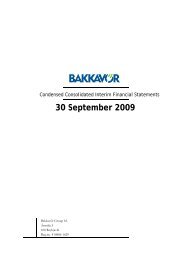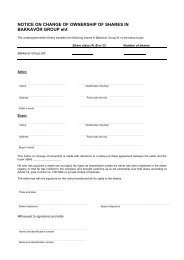Download our latest Annual Report - Bakkavor
Download our latest Annual Report - Bakkavor
Download our latest Annual Report - Bakkavor
You also want an ePaper? Increase the reach of your titles
YUMPU automatically turns print PDFs into web optimized ePapers that Google loves.
BAKKAVOR ANNUAL REPORT AND ACCOUNTS 2012<br />
notes to the consolidated financial statements<br />
continued<br />
2<br />
SIGNIFICANT ACCOUNTING POLICIES CONTINUED<br />
Revenue recognition<br />
Revenue is measured at the fair value of the consideration received or receivable and represents amounts receivable for goods provided in the normal<br />
c<strong>our</strong>se of business, net of discounts, VAT and other sales-related taxes.<br />
The Group sells fresh prepared foods and fresh produce.<br />
Revenue from the sales of these goods is recognised when all of the following conditions are satisfied:<br />
• the Group has transferred to the buyer the significant risks and rewards of ownership of the goods;<br />
• the Group retains neither continuing managerial involvement to the degree usually associated with ownership nor effective control over the<br />
goods sold;<br />
• the amount of revenue can be measured reliably;<br />
• it is probable that the economic benefits associated with the transaction will flow into the entity;<br />
• the costs incurred or to be incurred in respect of the transaction can be measured reliably.<br />
As a result, revenue for the sale of these goods is generally recognised upon delivery to the customer.<br />
Foreign currencies<br />
The individual financial statements of each Group company are presented in the currency of the primary economic environment in which it operates (its<br />
functional currency). For the purpose of the consolidated financial statements, the results and financial position of each Group company are expressed<br />
in Pounds Sterling, which is the functional currency of the Company, and the presentation currency for the consolidated financial statements.<br />
In preparing the financial statements of the individual companies, transactions in currencies other than the entity’s functional currency (foreign<br />
currencies) are recorded at the rates of exchange prevailing on the dates of the transactions. At each statement of financial position date, monetary<br />
assets and liabilities that are denominated in foreign currencies are retranslated at the rates prevailing on the statement of financial position date.<br />
Non-monetary items carried at fair value that are denominated in foreign currencies are translated at the rates prevailing at the date when the fair<br />
value was determined. Non-monetary items that are measured in terms of historical cost in a foreign currency are not retranslated.<br />
Exchange differences arising on the settlement of monetary items, and on the retranslation of monetary items, are included in the income statement<br />
for the period. Exchange differences arising on the retranslation of non-monetary items carried at fair value are included in the income statement for<br />
the period except for differences arising on the retranslation of non-monetary items carried at historical cost of which gains and losses are recognised<br />
directly in other comprehensive income.<br />
For the purpose of presenting consolidated financial statements, the assets and liabilities of the Group’s foreign operations are translated at exchange<br />
rates prevailing on the statement of financial position date. Income and expense items are translated at the annual average rate, unless exchange<br />
rates fluctuate significantly during that period, in which case the exchange rates at the date of transactions are used. Exchange differences arising,<br />
if any, are recognised in other comprehensive income and accumulated in the Group’s translation reserve.<br />
On the disposal of a foreign operation, all of the accumulated exchange differences in respect of that operation attributable to the Group are<br />
reclassified to the income statement. Goodwill and fair value adjustments arising on the acquisition of a foreign entity are treated as assets and<br />
liabilities of the foreign entity and translated at the closing rate.<br />
Research and development<br />
Research and development costs comprise all directly attributable costs necessary to create and produce new products which are both new in design<br />
and those being modified. Expenditure on research and development is recognised as an expense in the period in which it is incurred.<br />
Operating profit<br />
Operating profit is stated after (charging)/crediting exceptional items, disposal of subsidiaries and associates, impairment of assets and share of<br />
results of associates but before investment revenue and finance costs.<br />
Retirement benefit obligations<br />
Defined contribution plans<br />
A defined contribution plan is a pension plan under which the Group pays fixed contributions into a separate entity, which then invests the contributions<br />
to buy annuities for the pension liabilities as they become due based on the value of the fund and hence the Group has no legal or constructive<br />
obligations to pay further contributions. Obligations for contributions to defined contribution pension plans are recognised as an expense in the income<br />
statement as employee service is received. Prepaid contributions are recognised as an asset to the extent that a cash refund or a reduction in future<br />
payments is available. Payments made to state-managed retirement benefit schemes are dealt with as payments to defined contribution schemes<br />
where the Group’s obligations under the schemes are equivalent to those arising in a defined contribution retirement benefit scheme.<br />
PAGE 63 VIEW THE FULL REPORT AT ANNUALREPORT12.BAKKAVOR.COM










